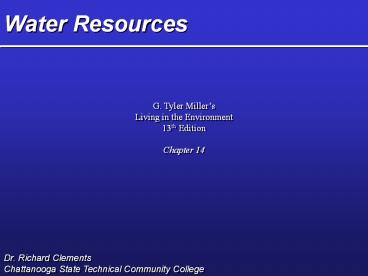Water Resources PowerPoint PPT Presentation
1 / 32
Title: Water Resources
1
Water Resources
G. Tyler Millers Living in the Environment 13th
Edition Chapter 14
Dr. Richard Clements Chattanooga State Technical
Community College
2
Waters Unique Properties
- Hydrogen bonding
- Liquid over wide temperature range
- Changes temperature slowly
- High heat of evaporation
- Great dissolving power
- pH
- Adhesion and cohesion
- Expands when it freezes
3
Supply of Water Resources
Fig. 14-2 p. 314
4
Surface Water
- Surface runoff
- Reliable runoff
- Watershed
- Drainage basin
5
Ground Water
Fig. 14-3 p. 315
6
Use of Water Resources
- Humans use about 50 of reliable runoff
- Agriculture
- Industry
- Domestic
- Power plants
Fig. 14-5 p. 316
7
Too Little Water
- Dry climate
- Drought
- Dessication
- Water stress
Fig. 14-7 p. 317
8
Using Dams and Reservoirs to Supply More Water
Fig. 14-9 p. 319
9
Transferring Water from One Place to Another
- Watershed transfer
- California Water Project
- Central Arizona Project
- James Bay
Fig. 14-13 p. 323
10
Tapping Groundwater
- Year-round use
- No evaporation losses
- Often less expensive
- Potential Problems!
11
Problems with Using Groundwater
- Water table lowering (See Fig. 14-15 p. 326)
- Depletion (See Fig. 14-16 p. 326)
- Subsidence (See Fig. 14-16 p. 326)
- Saltwater intrusion (See Fig. 14-17 p. 328)
- Chemical contamination
See Case Study p. 327
- Reduced stream flows
12
Converting Salt Water to Fresh Water and Making
it Rain
- Distillation desalination
- Reverse osmosis desalination
- Desalination is very expensive
- Cloud seeding
13
Using Water More Efficiently
- Reduce losses due to leakage
- Reform water laws
- Improve irrigation efficiency (Fig. 14-18 p. 330)
- Improving manufacturing processes
- Water efficient landscaping
- Water efficient appliances
14
Too Much Water Floods
- Natural phenomena
- Aggravated by human activities
- Renew and replenish
Reservoir
Dam
Levee
Flood wall
Floodplain
Fig. 14-22 p. 332
15
Solutions Achieving a More Sustainable Water
Future
- Efficient irrigation
- Water-saving technologies
- Improving water management
See Fig. 14-25 p. 336
16
Water Pollution
G. Tyler Millers Living in the Environment 13th
Edition Chapter 19
Dr. Richard Clements Chattanooga State Technical
Community College
17
Types and Sources of Water Pollution
- Point sources
Refer to Tables 19-1 and 19-2 p. 484 and 485
- Nonpoint sources
- Biological oxygen demand
- Water quality
18
Point and Nonpoint Sources
Fig. 19-4 p. 486
19
Pollution of Streams
- Oxygen sag curve
- Factors influencing recovery
Fig. 19-5 p. 488
20
Pollution of Lakes
- Eutrophication
- Slow turnover
- Thermal stratification
21
Case Study The Great Lakes
Fig. 19-8 p. 492
22
Groundwater Pollution Sources
- Low flow rates
- Cold temperatures
- Few bacteria
Hazardous waste injection well
Pesticides
Coal strip mine runoff
De-icing road salt
Buried gasoline and solvent tank
Cesspool septic tank
Pumping well
Gasoline station
Waste lagoon
Water pumping well
Sewer
Landfill
Leakage from faulty casing
Accidental spills
Discharge
Unconfined freshwater aquifer
Confined aquifer
Fig. 19-10 p. 494
Confined freshwater aquifer
Groundwater flow
23
Groundwater Pollution Prevention
- Monitoring aquifers
- Leak detection systems
- Strictly regulating hazardous waste disposal
- Storing hazardous materials above ground
24
Ocean Pollution
Fig. 19-12 p. 498
25
Case Study Chesapeake Bay
- Largest US estuary
- Relatively shallow
- Slow flushing action to Atlantic
- Major problems with dissolved O2
26
Oil Spills
- Sources offshore wells, tankers, pipelines and
storage tanks
- Effects death of organisms, loss of animal
insulation and buoyancy, smothering
- Significant economic impacts
- Mechanical cleanup methods skimmers and blotters
- Chemical cleanup methods coagulants and
dispersing agents
27
Solutions Preventing and Reducing Surface Water
Pollution
Nonpoint Sources
Point Sources
- Reduce runoff
- Clean Water Act
- Buffer zone vegetation
- Water Quality Act
- Reduce soil erosion
28
Technological Approach Septic Systems
- Require suitable soils and maintenance
Fig. 19-16 p. 504
29
Technological Approach Sewage Treatment
- Mechanical and biological treatment
Fig. 19-17p. 504
30
Technological Approach Advanced Sewage Treatment
- Removes specific pollutants
Fig. 19-18p. 505
31
Technological Approach Using Wetlands to Treat
Sewage
Fig. 19-19p. 506
32
Drinking Water Quality
- Bottled water
- Safe Drinking Water Act
- Maximum contaminant levels

